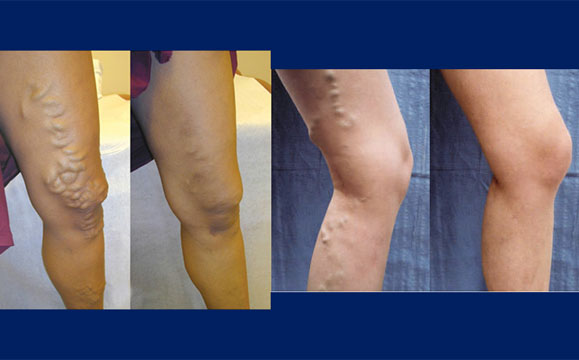Minimally Invasive Treatment for Varicose Veins Now Available to Patients at UCSF Radiology

At UCSF Radiology, interventional radiologists use minimally invasive procedures as surgical alternatives for treatment of varicose veins. Varicose veins are the dark blue or purple leg veins that protrude above the skin's surface. There are many factors that can cause varicose veins, such as increasing age, family history of varicose veins, prior blood clots in the legs, obesity, or pregnancy. This condition is said to affect nearly one third of all adults, and besides cosmetic concerns and considerations, complications can include burning, heaviness, swelling, pain in the legs, discomfort walking, and skin changes, including ulcers. Treatment of varicose veins can help relieve discomfort and also prevent further complications.
Most are familiar with the older, surgical treatment for varicose veins, known as surgical ligation and stripping, which involves surgically removing the affected vein segment from the body. Surgery has recently been replaced by minimally-invasive alternatives. At UCSF Radiology, our practice uses a technique where the vein is treated from the inside through a small skin incision. Overall, endovenous ablation is equally as effective as traditional surgery, with shorter recovery times, faster return to work and healing times.
Ideal candidates for minimally-invasive treatment for varicose veins include healthy patients with lower extremity venous reflux, or symptoms suggestive of reflux. Treatment options can be discussed in detail with our interventional radiologists. The types of non-surgical alternatives for varicose vein treatment available at UCSF Radiology include:
- Radiofrequency ablation, also known as RF ablation, which uses heat to treat and close the affected great saphenous vein from the inside. RF ablation may not be able to treat veins close to the skin.
- VenaSealTM, an alternative to both surgical stripping and radiofrequency ablation, which uses a cyanoacrylate glue, rather than heat, to treat the affected vein segment from the inside. VenaSealTM can be used to treat veins close to the surface.
- Vein sclerosis, which is used to treat smaller reticular (spider) veins using targeted injection of liquid or foam sclerosant medication.
Overall, the risk for varicose veins can be lowered by good blood circulation, fitness, and a healthy diet high in fiber and low in salt. Also, it's helpful to regularly change sitting or standing positions and consider regular use of compression stockings. Learn more about varicose veins symptoms and treatment at UCSF.
